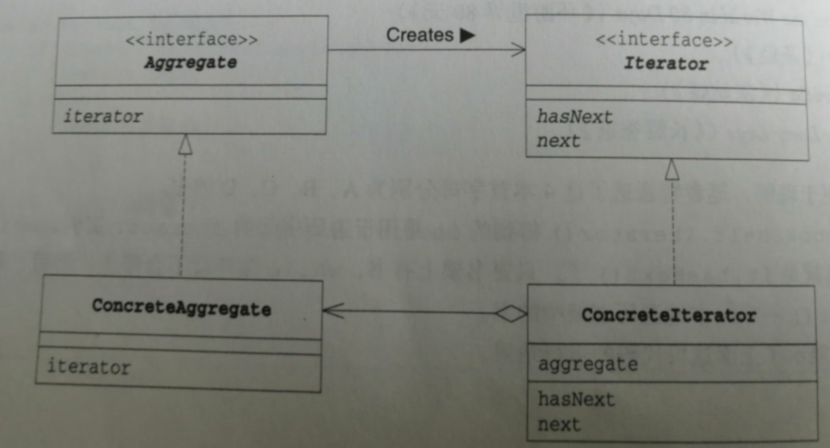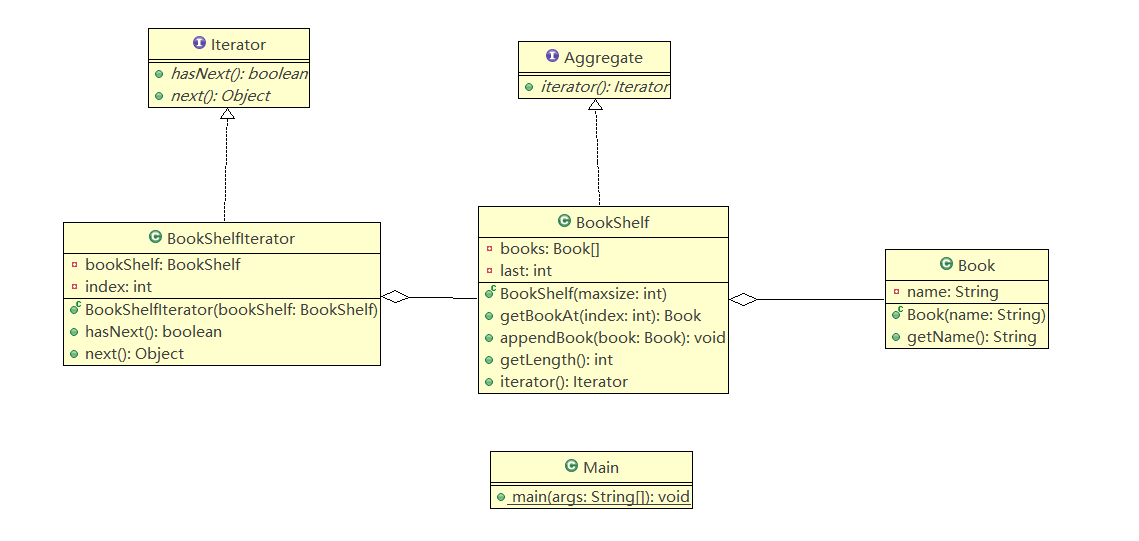文章目录
- Iterator模式
- 应用场景
- 本质
- 优点
- 缺点
- 角色
- 设计模式的类图
- 示例程序
- 示例程序的类图
- 示例代码
- 拓展思路
- 相关设计模式
- 满足的原则
Iterator模式
应用场景
- 访问一个聚合对象的内容而无需暴露它的内部表示
- 支持对聚合对象的多种遍历(从前到后,从后到前)
- 为遍历不同的聚合结构提供一个统一的接口,即支持多态迭代。
本质
- 逐一遍历
优点
- 它支持以不同的方式遍历一个聚合对象,在同一个聚合对象上可以定义多种遍历方式。在迭代器模式中只需要用一个不同的迭代器来替换原有迭代器即可改变遍历算法,我们也可以自己定义迭代器的子类以支持新的遍历方式。
- 迭代器简化了聚合类。由于引入了迭代器,在原有的聚合对象中不需要再自行提供数据遍历等方法,这样可以简化聚合类的设计。
- 在迭代器模式中,由于引入了抽象层,增加新的聚合类和迭代器类都很方便,无须修改原有代码,满足 “开闭原则” 的要求。
缺点
- 由于迭代器模式将存储数据和遍历数据的职责分离,增加新的聚合类需要对应增加新的迭代器类,类的个数成对增加,这在一定程度上增加了系统的复杂性。对于比较简单的遍历(像数组或者有序列表),使用迭代器方式遍历较为繁琐。
- 迭代器模式在遍历的同时更改迭代器所在的集合结构会导致出现异常。所以使用foreach语句只能在对集合进行遍历,不能在遍历的同时更改集合中的元素。
角色
- 迭代器角色(Iterator): 定义迭代器访问和遍历元素的接口
- 具体迭代器角色(ConcreteIterator): 实现具体的迭代器
- 集合角色(Aggregate): 定义的容器,创建相应迭代器对象的接口
- 具体集合角色(ConcreteAggregate): 具体的容器实现创建相应迭代器的接口,该操作返回ConcreteIterator的一个适当的实例。
设计模式的类图

示例程序
示例程序的类图

示例代码
public interface Aggregate {
public abstract Iterator iterator();
}
public class Book {
private String name;
public Book(String name) {
this.name = name;
}
public String getName() {
return name;
}
}
public class BookShelf implements Aggregate {
private Book[] books;
private int last = 0;
public BookShelf(int maxsize) {
this.books = new Book[maxsize];
}
public Book getBookAt(int index) {
return books[index];
}
public void appendBook(Book book) {
this.books[last] = book;
last++;
}
public int getLength() {
return last;
}
public Iterator iterator() {
return new BookShelfIterator(this);
}
}
public class BookShelfIterator implements Iterator {
private BookShelf bookShelf;
private int index;
public BookShelfIterator(BookShelf bookShelf) {
this.bookShelf = bookShelf;
this.index = 0;
}
public boolean hasNext() {
if (index < bookShelf.getLength()) {
return true;
} else {
return false;
}
}
public Object next() {
Book book = bookShelf.getBookAt(index);
index++;
return book;
}
}
public interface Iterator {
public abstract boolean hasNext();
public abstract Object next();
}
import java.util.*;
public class Main {
public static void main(String[] args) {
BookShelf bookShelf = new BookShelf(4);
bookShelf.appendBook(new Book("Around the World in 80 Days"));
bookShelf.appendBook(new Book("Bible"));
bookShelf.appendBook(new Book("Cinderella"));
bookShelf.appendBook(new Book("Daddy-Long-Legs"));
Iterator it = bookShelf.iterator();
while (it.hasNext()) {
Book book = (Book)it.next();
System.out.println(book.getName());
}
}
}
拓展思路
- 迭代器的种类多种多样
- Java中,没有被使用的对象实例会自动GC
- 不管实现如何变化,都可以使用 Iterator
相关设计模式
-
Visitor 模式
Iterator模式是从集合中-一个一个取出元素进行遍历,但是并没有在Iterator接口中声明对取出的元素进行何种处理。
Visitor模式则是在遍历元素集合的过程中,对元素进行相同的处理。
在遍历集合的过程中对元素进行固定的处理是常有的需求。Visitor 模式正是为了应对这种需求而出现的。在访问元素集合的过程中对元素进行相同的处理,这种模式就是Visitor模式。 -
Composite模式
Composite模式是具有递归结构的模式,在其中使用Iterator 模式比较困难。 -
Factory Method模式
在iterator方法中生成Iterator的实例时可能会使用Factory Method模式。
满足的原则
- 开放封闭原则
- 单一职责原则
最后
以上就是拉长草莓最近收集整理的关于一个一个遍历的 Iterator模式Iterator模式的全部内容,更多相关一个一个遍历的内容请搜索靠谱客的其他文章。
本图文内容来源于网友提供,作为学习参考使用,或来自网络收集整理,版权属于原作者所有。








发表评论 取消回复